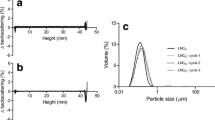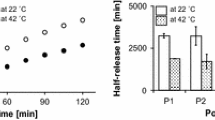Abstract
A drug delivery system for the paranasal sinuses consisting of a freeze-dried thermoresponsive hydrogel with degradable microspheres, called FD-TEMPS (Freeze Dried—Thermogel, Extended-release Microsphere-based delivery to the Paranasal Sinuses), was developed. Glass transition temperatures (Tg′) of the maximally freeze concentrated solutions consisting of poly(N-isopropylacrylamide) (pNIPAAm) and polyethylene glycol (PEG) were determined by differential scanning calorimetry, which informed optimization of the thermogel formulation. By replacing low molecular weight (MW) PEG (200 Da) with a higher MW PEG (2000 Da), the resulting freeze-dried gel exhibited a brittle texture, porous structure, and low residual moisture (< 3% measured by thermal gravimetric analysis). When combined with poly(lactic-co-glycolic acid) microspheres (PLGA MSs) and freeze dried, the complete system (FD-TEMPS) exhibited enhanced shelf-stability. Specifically, the smooth, spherical morphology of the MSs and initial release kinetics were maintained following 6 weeks of storage under ambient conditions. Furthermore, FD-TEMPS remained in place after application to a simulated mucosal surface, suggesting that it could be more uniformly distributed along the sinonasal mucosa in vivo. Freeze drying enables this delivery system to be stored as a ready-to-use product for better ease of clinical translation without compromising the thermoresponsive or sustained release characteristics that would enable local delivery of therapeutics to the sinonasal mucosa.
Graphical abstract








Similar content being viewed by others
Availability of data and material
Available upon request.
Code availability
Not applicable.
References
Orlandi RR, Kingdom TT, Hwang PH, Smith TL, Alt JA, Baroody FM, et al. International Consensus Statement on Allergy and Rhinology: Rhinosinusitis. Int Forum Allergy Rhinol. 2017;6:S22-209.
Rosenfeld RM, Piccirillo JF, Chandrasekhar SS, Brook I, Kumar KA, Kramper M, et al. Clinical practice guideline (update): adult sinusitis. Otolaryngology Head Neck Surg. 2015;152:S1-39.
Leal J, Smyth HDC, Ghosh D. Physicochemical properties of mucus and their impact on transmucosal drug delivery. Int J Pharm. 2017;532:555–72.
Möller W, Schuschnig U, Celik G, Münzing W, Bartenstein P, Häussinger K, et al. Topical drug delivery in chronic rhinosinusitis patients before and after sinus surgery using pulsating aerosols. Plos One. 2013;8:e74991.
Harvey RJ, Goddard JC, Wise SK, Schlosser RJ. Effects of endoscopic sinus surgery and delivery device on cadaver sinus irrigation. Otolaryngol Head Neck Surg. 2008;139:137–42.
Han JK, Kern RC. Topical therapies for management of chronic rhinosinusitis: steroid implants. Int Forum Allergy Rhinol. 2019;9:S22–6.
Douglas RG, Psaltis AJ, Rimmer J, Kuruvilla T, Cervin A, Kuang Y. Phase 1 clinical study to assess the safety of a novel drug delivery system providing long-term topical steroid therapy for chronic rhinosinusitis. Int Forum Allergy Rhinol. 2019;9:378–87.
Wei CC, Kennedy DW. Mometasone implant for chronic rhinosinusitis. Med Devices (Auckl). 2012;5:75–80.
Kern RC, Stolovitzky JP, Silvers SL, Singh A, Lee JT, Yen DM, et al. A phase 3 trial of mometasone furoate sinus implants for chronic sinusitis with recurrent nasal polyps. Int Forum Allergy Rhinol. 2018;8:471–81.
Sharma U, Concagh D, Core L, Kuang Y, You C, Pham Q, et al. The development of bioresorbable composite polymeric implants with high mechanical strength. Nat Mater. 2018;17:96–103.
Schilling AL, Kulahci Y, Moore J, Wang EW, Lee SE, Little SR. A thermoresponsive hydrogel system for long-acting corticosteroid delivery into the paranasal sinuses. J Control Release. 2021;330:889–97.
Tang X (Charlie), Pikal MJ. Design of freeze-drying processes for pharmaceuticals: practical advice. Pharmaceut Res. 2004;21:191–200.
Franks F. Freeze-drying of bioproducts: putting principles into practice. Eur J Pharm Biopharm. 1998;45:221–9.
Carpenter JF, Pikal MJ, Chang BS, Randolph TW. Rational design of stable lyophilized protein formulations: some practical advice. Pharmaceut Res. 1997;14:969–75.
Gizurarson S. The effect of cilia and the mucociliary clearance on successful drug delivery. Biological Pharm Bulletin. 2015;38:497–506.
Bellotti E, Fedorchak MV, Velankar S, Little SR. Tuning of thermoresponsive pNIPAAm hydrogels for the topical retention of controlled release ocular therapeutics. J Mater Chem B [Internet]. 2019;7:1276–83. Available from: https://doi.org/10.1039/C8TB02976H
Galgatte UC, Kumbhar AB, Chaudhari PD. Development of in situ gel for nasal delivery: design, optimization, in vitro and in vivo evaluation. Drug Deliv. 2014;21:62–73.
Lungare S, Bowen J, Badhan R. Development and evaluation of a novel intranasal spray for the delivery of amantadine. J Pharm Sci. 2016;105:1209–20.
Hatakeyama H, Hatakeyama T. Interaction between water and hydrophilic polymers. Thermochim Acta. 1998;308:3–22.
H.G. S. Poly (N-isopropylacrylamide): experiment, theory and application. Prog Polym Sci [Internet]. 1992;17:163–249. Available from: https://www.sciencedirect.com/science/article/pii/007967009290023R
Pansare SK, Patel SM. Practical considerations for determination of glass transition temperature of a maximally freeze concentrated solution. AAPS PharmSciTech. 2016;17:805–19.
Keck T, Leiacker R, Riechelmann H, Rettinger G. Temperature profile in the nasal cavity. Laryngoscope. 2000;110:651–4.
Shan-Yang L, Ko-Shao C, Liang R-C. Drying methods affecting the particle sizes, phase transition, deswelling/reswelling processes and morphology of poly(N-isopropylacrylamide) microgel beads. Polymer. 1999;40:6307.
Chang-Jing C, Liang-Yin C, Jie Z, Hai-Dong W, Gang W. Effect of freeze-drying and rehydrating treatment on the thermo-responsive characteristics of poly(N-isopropylacrylamide) microspheres. Colloid Polym Sci [Internet]. 2008;286:571. Available from: https://doi.org/10.1007/s00396-007-1817-3
Liu X-M, Wang L-S, Wang L, Huang J, He C. The effect of salt and pH on the phase-transition behaviors of temperature-sensitive copolymers based on N-isopropylacrylamide. Biomaterials. 2004;25:5659–66.
K. L Samuel, Ying-Ying W, Denis W, Justin H. Micro- and macrorheology of mucus. Adv Drug Deliver Rev. 2009;61:86–100.
Lih-Min H, Nail SL. Measurement of glass transition temperatures of freeze-concentrated solutes by differential scanning calorimetry. Pharmaceut Res [Internet]. 1994;11:54. Available from: https://doi.org/10.1023/A:1018989509893
Sun G, Zhang XZ, Chu CC. Effect of the molecular weight of polyethylene glycol (PEG) on the properties of chitosan-PEG-poly(N-isopropylacrylamide) hydrogels. J Mater Sci Mater Med. 2008;19:2865–72.
Amin K, Dannenfelser R, Zielinski J, Wang B. Lyophilization of polyethylene glycol mixtures. J Pharm Sci. 2004;93:2244–9.
Houchin ML, Topp EM. Chemical degradation of peptides and proteins in PLGA: a review of reactions and mechanisms. J Pharm Sci. 2008;97:2395–404.
Teng XW, Cutler DC, Davies NM. Degradation kinetics of mometasone furoate in aqueous systems. Int J Pharm. 2003;259:129–41.
Rothstein SN, Little SR. A “tool box” for rational design of degradable controlled release formulations. J Mater Chem [Internet]. 2011;21:29–39. Available from: https://doi.org/10.1039/C0JM01668C
Schilling AL, Carcella AR, Moore J, Zahid M, Lo C, Wang EW, et al. Compatibility of a thermoresponsive and controlled release system for promoting sinonasal cilia regeneration. Macromol Biosci. 2021;2100277.
Sonje AG, Mahajan HS. Nasal inserts containing ondansetron hydrochloride based on chitosan–gellan gum polyelectrolyte complex: In vitro–in vivo studies. Mater Sci Eng C Mater Biol Appl. 2016;64:329–35.
Kianfar F, Antonijevic M, Chowdhry B, Boateng JS. Lyophilized wafers comprising carrageenan and pluronic acid for buccal drug delivery using model soluble and insoluble drugs. Colloids Surf B: Biointerfaces. 2013;103:99–106.
Acknowledgements
The work was supported by not-for-profit funding received through the Eye & Ear Foundation of Pittsburgh. The authors would like thank Dr. Dan Lamont for assistance with the thermal analysis. The graphical abstract was created with Biorender.com.
Funding
The work was supported by not-for-profit funding received through the Eye & Ear Foundation of Pittsburgh.
Author information
Authors and Affiliations
Contributions
A.L.S., S.E.L., E.W.W., and S.R.L. conceived of the presented idea. A.L.S. and E.C. carried out the experimental work with support from S.K.F. A.L.S. wrote the manuscript with input from E.C., S.K.F., S.E.L., E.W.W., and S.R.L.
Corresponding author
Ethics declarations
Ethics approval and consent to participate
Not applicable.
Consent for publication
Note applicable.
Conflict of interest
Not applicable.
Additional information
Publisher's Note
Springer Nature remains neutral with regard to jurisdictional claims in published maps and institutional affiliations.
Supplementary information
Below is the link to the electronic supplementary material.
Rights and permissions
About this article
Cite this article
Schilling, A.L., Cannon, E., Fullerton-Shirey, S.K. et al. A ready-to-use, thermoresponsive, and extended-release delivery system for the paranasal sinuses. Drug Deliv. and Transl. Res. 12, 708–719 (2022). https://doi.org/10.1007/s13346-021-01069-3
Accepted:
Published:
Issue Date:
DOI: https://doi.org/10.1007/s13346-021-01069-3




